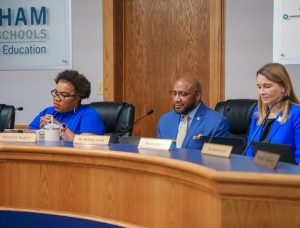Sign-language interpreters in the Durham schools demanded better pay during a school board meeting on Thursday. Meanwhile, dozens of Durham Association of Educators members and supporters called on the board to recognize the union and give it a stronger role in the planning process.
The comments by staff who serve deaf students came after department members called in sick on Thursday to protest insufficient pay.
After the district’s salary debacle, sign-language interpreters “now earn an average of $932 less per month than we were promised in October of 2023,” said interpreter Sarah Leonard, reading from a letter from the staff to the board.
“Due to this change, many of us are contemplating leaving the district in order to support ourselves and our families with community positions that pay significantly more. If we are forced to leave, the district will find itself in a precarious position, both financially and legally,” Leonard continued.
Other DPS staff also spoke about salary issues at the meeting. Christie Clem, a DAE member and physical therapist, called for more transparency about future pay rates.
“The classified pay crisis caused employees to leave and destroyed our trust not only with the board but also with administration,” she said. “Classified employees don’t feel any better now than we did in January.”
Interim Superintendent Catty Moore said the district hopes to release individual salary projections for the next school year by the end of this week.
Clem was among more than 35 individuals who turned out to advocate for the Durham Association of Educators on Thursday. The advocates, many wearing DAE T-shirts and carrying homemade signs, called on the board to formally recognize the union and to establish a “formal meet and confer policy” by the start of the upcoming school year.
Representatives from nine other unions — including the Union of Southern Service Workers, the Duke Graduates Students Union, and National Nurses United — spoke out in solidarity with the DAE.
DAE President Symone Kiddoo laid out a clear timeline for the board.
“If the board is not ready to formalize union recognition this year, we can take the summer to do all that we can to get on the same page about this…If, after that, the board does not pass a standard union recognition policy at or near the start of the school year, we will have to spend the next year at loggerheads as well.”
North Carolina is among the few states where public-sector employees are prohibited from engaging in collective bargaining. DAE views meet and confer as an “alternative framework for honoring workers’ rights.”
Efforts to establish a meet and confer policy have been ongoing in Durham. On February 15, DAE members met with the school board, leading to the formation of an ad hoc committee to work towards a meet and confer policy. However, the committee has been in tension.
DAE members walked out of a May 20 ad hoc committee meeting after hearing the board’s proposed policy.
The DAE posted on Facebook the following day that “our talks with the district about union recognition have broken down. Despite the fact that we now represent a majority of DPS workers, the board continues to delay the process, divide workers, and discredit our organizing.”
Alongside urging the board to establish a formal policy, DAE members expressed anguish over the current state of the district.
“We are in triage. We are in the trenches, as you already know. We can’t wait. We are in the middle of a staffing crisis and basically fueled by pay cuts, lack of trust in the district, quality teachers are leaving left and right, it’s like we’re bleeding from the arteries,” said educator Shamia Truitt.
Also on Thursday, members of the public made another appeal to renovate the current Durham School of the Arts rather than build a replacement school. Moore reiterated that plans to build a new Durham School of the Arts will proceed.
Speakers argued that the funds for the new construction, now estimated at more than $240 million, could better be allocated to aid in facility maintenance at other schools. Several also pointed out the historical, cultural, and emotional significance of the current DSA site.
“It is vital that a school that calls itself the School of the Arts have a significant and visible presence in the downtown corridor,” said designer and two-time DSA parent Alicia Hylton-Daniel. “DSA’s current location does that, and so much more. The location tells a story of preservation and significant progress as it went from an all-white Durham high school to the cultured, diverse student body makeup it is today.”




